What's the most important thing to know about stars? Their brightness (apparent magnitude) might top the list, but right behind would be the spectral types. Without its spectral type a star is a meaningless dot. Add a few letters and numbers like "G2V" or "B5IV-Vshnne" and the star suddenly gains personality and character. To those who can read its meaning, the spectral code tells at a glance just what kind of object the star really is: its color, size, and luminosity compared to the Sun and stars of all other types; its peculiarities, its history, and its future.
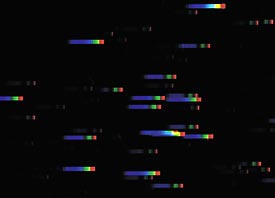
Mass-producing stellar spectra. A thin prism was placed in front of the telescope to spread out starlight from the Hyades cluster into little rainbows, or spectra. Spectra contain the 'fingerprints' astronomers use to deduce myriad stellar properties. Click on this image to see some of these stellar spectra up close.
University of Michigan Department of Astronomy
The modern spectral classification system is so successful that it has hardly been changed since 1943. It is based on just two physical properties that imprint themselves on the spectrum of a star's light: the star's surface temperature and atmospheric pressure. These reveal an abundance of information that paints the star's portrait and tells its life story.
The temperature sets the star's color and determines its surface brightness: how much light comes from each square meter of its surface. The atmospheric pressure depends on the star's surface gravity and therefore, roughly, on its size — telling whether it is a giant, dwarf, or something in between. The size and surface brightness in turn yield the star's luminosity (its total light output, or absolute magnitude) and often its evolutionary status (young, middle-aged, or nearing death). The luminosity (when compared to the star's apparent brightness in our sky) also gives a good idea of the star's distance. Appended to the basic spectral type may be letters for chemical peculiarities, an extended atmosphere, unusual surface activity, fast rotation, or other special characteristics.
Every starwatcher needs to have a feel for spectral types.
Important things to know about Spectral Types of Stars
Dissecting Starlight
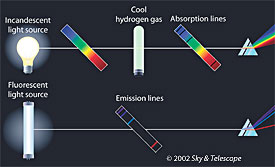
Whether in a star's atmosphere or in a laboratory, absorption lines are produced when a continuous rainbow of light from a hot, dense object (top left) passes through a cooler, more rarefied gas (top center). Emission lines, by contrast, come from an energized, rarefied gas such as in a neon light or a glowing nebula.
S&T / Steven Simpson
Our tale began in 1802, when the English experimenter William Wollaston passed a beam of sunlight through a thin slit and then through a prism. The slit provided a sharp, high-resolution view of the familiar rainbow spectrum, with no color overlapping another. When seen this way, Wollaston noticed, the Sun's spectrum was marked by many narrow, black lines of various intensities. These dark lines stayed at exactly the same places in the colorful band from day to day and year to year. They were later measured and cataloged by Josef von Fraunhofer, for whom they are still called "Fraunhofer lines."
Similar spectral lines showed up in laboratory experiments. Using a slit and prism, physicists discovered that when a solid, liquid, or dense gas is heated to glow, it emits a smooth spectrum of light with no lines: a continuum. A rarefied hot gas, on the other hand, glows only in certain colors, or wavelengths: bright, narrow emission lines instead of a rainbow band. If a cooler sample of the same gas is placed in front of a glowing object emitting a continuum, dark absorption lines appear at the wavelengths where the emission lines would be if the gas were hot.

British amateur spectroscopist Maurice Gavin obtained this solar spectrum — a 'rainbow' of sunlight with thin, dark absorption lines at numerous discrete wavelengths. Each chemical element creates its own unique set of spectral lines.
By 1859 the situation was clear: we see the Sun's hot, relatively dense surface through a cooler solar atmosphere that imposes the dark lines.
Here, scientists realized, was a way to bring the Sun down into the laboratory. Every element, every chemical compound, shows its own set of spectral lines. They are as unique as fingerprints. They reveal not only which atoms and molecules are present but also many other physical conditions, starting with temperature. And when astronomers put the same slit-and-prism device (a spectroscope) on a telescope, they could even see spectral lines in the light of stars.
It was the 19th century's greatest astronomical breakthrough. Philosophers had cited the makeup of stars as an example of something that was beyond all possible human knowing. Now finding the composition of the Sun and stars was just a matter of comparing spectral lines seen in a telescope with those seen in a laboratory. This wasn't always simple, but it gave birth to modern astrophysics — the treatment of stars as physical objects to be studied and understood, rather than as mere points of light on the sky to be measured.
Ordering Stellar Spectra
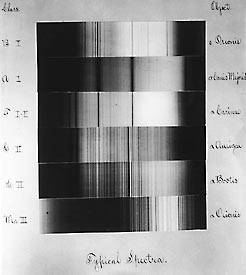
Early stellar spectra showing the distinctive absorption lines that astronomers used (and use still) to determine stars' compositions and temperatures. This set of spectra comes from the original Henry Draper Catalogue.
Harvard College Observatory
The first great classifier of stellar spectra was Angelo Secchi, a Jesuit priest in Rome. In the 1860s he examined the spectra of hundreds of stars visually in a telescope and classed them into five main types, mostly named for bright examples. "Sirian" stars, for instance, showed spectra like Sirius's, dominated by absorption lines of hydrogen atoms.
Today's classification scheme was born at Harvard College Observatory. Starting in 1886 under Edward C. Pickering, the observatory staff photographed and classified thousands of spectral types. They assigned them letters from A through Q, generally in alphabetical order from the simplest-looking to the most complex. But soon a more natural system became clear. By rearranging and merging classifications, Antonia C. Maury and Annie J. Cannon found that they could fit nearly all stars' spectra into one smooth, continuous sequence. The sequence matched the stars' color temperatures, from the hottest, blue-white stars at one end to relatively cool, orange-red ones at the other.
But it was too late to reassign the letters. When the dust cleared, the rearranged sequence ran O B A F G K M from hot to cool. Spectral types on the blue end were called "early" and those on the red end "late." These terms are still used today, though the incorrect idea they embody — that stars simply cool with age — has been obsolete for generations.
The sequence could be cut even more finely. Cannon subdivided each letter with numbers from 0 to 9, so that a spectrum whose appearance placed it halfway between standard G0 and K0 stars was called G5.
Using this scheme, Cannon led the classification at Harvard of 325,300 spectra recorded on wide-field photographs. The resulting Henry Draper Catalogue (HD) and Henry Draper Extension (HDE), published beginning in 1918, remain standard references today.
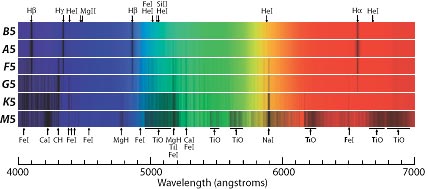
Stellar spectra from hot to cool. A star's temperature largely determines which dark absorption lines appear in its spectrum. Although these spectra look like the real thing, they're artificial — the output of a computer model by Roger Bell (University of Maryland) that subjects a solar-type mixture of theoretical atoms to different temperatures at the pressures that prevail in the outer layers of dwarf (main-sequence) stars.
Michael Briley, University of Wisconsin, Oshkosh
The time-honored mnemonic for remembering the spectral sequence, invented by Henry Norris Russell when astronomy's leadership was all male, is "Oh Be A Fine Girl Kiss Me." In 1995 Mercury magazine published a student's rejoinder: "Only Boys Accepting Feminism Get Kissed Meaningfully."
The discovery in recent years of very dim, very red objects — the smallest, coolest red dwarf stars and barely glowing "brown dwarfs" — has led to the creation of three new spectral types past M. These are L, T, and Y, chosen from among the few remaining letters that might not have some other, confusing meaning. So now the full spectral sequence runs O B A F G K M L T Y.
A few other spectral types don't fit the sequence but instead parallel it. Type W or Wolf-Rayet stars are as hot and blue as the hottest O stars but show strong emission lines, either of nitrogen (WN), carbon and oxygen (WC), or neither (WR). Emission lines indicate an especially large, thick shroud of hot gas surrounding these stars. The W stars appear to have blown off their original outer layers of hydrogen, exposing other materials beneath.
Some giant stars at the cool end of the spectrum have an excess of carbon. These were originally called R and N but have been merged to form type C. "Carbon stars" can often be spotted at a glance in a telescope by their deep red color. A bright example in the autumn sky is 19 Piscium (TX Piscium) in the Circlet of Pisces, spectral type C5. Their distinctive absorption bands (masses of overlapping spectral lines) due to the carbon compounds C2, CN, and CH darken or "blanket" the blue end of the spectrum. In other words, a carbon star's atmosphere is a red filter. When seen in emission instead of absorption, these same spectral bands glow blue; the same compounds that redden a carbon star in absorption give comets their blue-green tint in emission.
The rare type-S stars are also red giants. They parallel type M but show strong bands of zirconium oxide and lanthanum oxide instead of an M star's titanium oxide. We can imagine that planets of S stars, bathed in chemically peculiar stellar winds, might be encrusted with gems of cubic zirconia.
Dwarfs and Giants
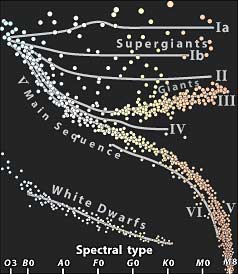
A Hertzsprung-Russell diagram plots stars' spectral types against their intrinsic luminosities (absolute magnitudes). Most stars lie either on the hydrogen-fusing main sequence or on the giant branch. A scattering of supergiants spans all spectral types. Click for the full view, where many real stars are labeled.
Sky & Telescope / Source: James Kaler
Even in stars of the same spectral type, the absorption lines don't always look alike. In some stars the lines are narrow and sharp; in others they are broadened by various different effects. Chief among these effects is atmospheric pressure, which also changes the intensity ratios of certain pressure-sensitive lines.
Astronomers quickly realized that atmospheric pressure tells a star's surface gravity and therefore suggests its size. Narrow lines indicate an immense, bloated star with a weakly compressed atmosphere far from its center of gravity. In the Henry Draper Catalogue, spectral types were prefixed with d for dwarf, sg for subgiant, g for giant, and c for supergiant.
You'll still run across these letters from time to time, but beginning in 1941 they were replaced by a more detailed scheme first published by William W. Morgan and Philip C. Keenan. With only minor changes, this "MK" system of spectral classification remains the standard today. Stars are assigned to luminosity classes by Roman numerals: I for supergiants (often subdivided into classes Ia-0, Ia, Iab, and Ib in order of decreasing luminosity), II for bright giants, III for normal giants, IV for subgiants, V for dwarfs on the main sequence (defined in the illustration below), and occasionally VI for subdwarfs.
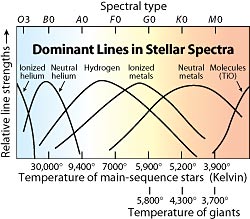
Different atoms and ions leave their fingerprints on starlight at different temperatures. Conditions must be fine-tuned to bring out a given chemical 'fingerprint.' Hydrogen, for instance, only shows up strongly in spectra near type A — even though it makes up the bulk of almost all stars. And hundreds of lines from 'metals' (elements heavier than helium) dominate the spectra of cooler K-type stars, even though metals make up just a tiny fraction of those stars' masses.
Sky &Telescope
Thus a designation such as G2V, the Sun's spectral type, tells both temperature and luminosity. When these quantities are plotted against each other on a graph, the result (shown at right) is called a Hertzsprung-Russell or H-R diagram. This has been a fundamental astrophysical tool ever since it was invented around 1911.
Most stars gather in certain narrow regions of the H-R diagram according to their masses and ages. Stars arrive on what's called the main sequence soon after they are born, and this evolutionary track is where they spend most of their lives. Massive stars blaze brightly on the hot, blue end of the main sequence. They burn up their nuclear fuel in only millions or tens of millions of years. Stars with lower masses comprise the yellow, orange, and red dwarfs on the lower-right part of the main sequence, where they remain for billions of years.
As a star begins to exhaust the hydrogen fuel in its core, it evolves away from the main sequence toward the upper right and becomes a red giant or supergiant. Stars that began with more than eight times the Sun's mass then evolve left and right through complicated loops on the H-R diagram as if in a frenzy to keep up their energy production. Then they finally explode as supernovae. Less massive giants evolve to the left and then down to become white dwarfs; this is the track the Sun will trace through the H-R diagram 8 billion years from now.
Odds and Ends
Spectra can reveal many other things about stars. Accordingly, lowercase letters are sometimes added to the end of a spectral type to indicate peculiarities. Here is a partial list:

 0
0








Comments
You must be logged in to post a comment.